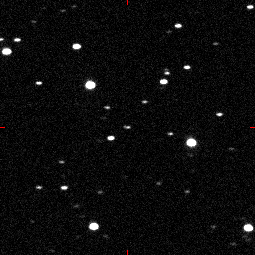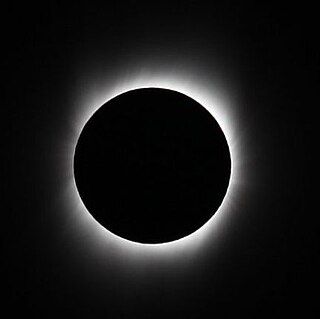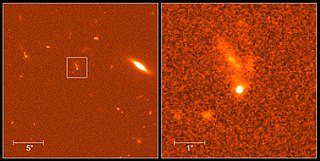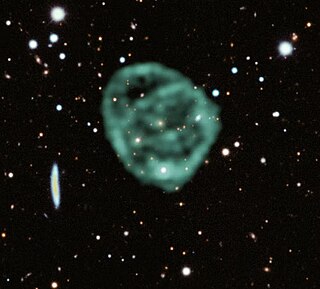Related Research Articles

In gamma-ray astronomy, gamma-ray bursts (GRBs) are immensely energetic explosions that have been observed in distant galaxies, described by NASA as "the most powerful class of explosions in the universe". They are the most energetic and luminous electromagnetic events since the Big Bang. Bursts can last from ten milliseconds to several hours. After an initial flash of gamma rays, a longer-lived "afterglow" is usually emitted at longer wavelengths.

Astronomy is a natural science that studies celestial objects and phenomena. It uses mathematics, physics, and chemistry in order to explain their origin and evolution. Objects of interest include planets, moons, stars, nebulae, galaxies, meteoroids, asteroids, and comets. Relevant phenomena include supernova explosions, gamma ray bursts, quasars, blazars, pulsars, and cosmic microwave background radiation. More generally, astronomy studies everything that originates beyond Earth's atmosphere. Cosmology is a branch of astronomy that studies the universe as a whole.


The European Organisation for Astronomical Research in the Southern Hemisphere, commonly referred to as the European Southern Observatory (ESO), is an intergovernmental research organisation made up of 16 member states for ground-based astronomy. Created in 1962, ESO has provided astronomers with state-of-the-art research facilities and access to the southern sky. The organisation employs over 750 staff members and receives annual member state contributions of approximately €162 million. Its observatories are located in northern Chile.

Stefano Sposetti is a Swiss amateur astronomer and a prolific discoverer of minor planets. He lives in Gnosca, in the Italian-speaking part of Switzerland in the Ticino Alps, where the Gnosca Observatory is located.

Pisgah Astronomical Research Institute (PARI) is a non-profit astronomical observatory located in the Pisgah National Forest near Balsam Grove, North Carolina. PARI operates multiple radio telescopes and optical telescopes for research and teaching purposes. The observatory is affiliated with the University of North Carolina system through the Pisgah Astronomical Research and Science Educational Center (PARSEC).

Neil Gehrels Swift Observatory, previously called the Swift Gamma-Ray Burst Explorer, is a NASA three-telescope space observatory for studying gamma-ray bursts (GRBs) and monitoring the afterglow in X-ray, and UV/Visible light at the location of a burst. It was launched on 20 November 2004, aboard a Delta II launch vehicle. Headed by principal investigator Neil Gehrels until his death in February 2017, the mission was developed in a joint partnership between Goddard Space Flight Center (GSFC) and an international consortium from the United States, United Kingdom, and Italy. The mission is operated by Pennsylvania State University as part of NASA's Medium Explorer program (MIDEX).

Frank Kelley Edmondson was an American astronomer.
The Bruno Rossi Prize is awarded annually by the High Energy Astrophysics division of the American Astronomical Society "for a significant contribution to High Energy Astrophysics, with particular emphasis on recent, original work". Named after astrophysicist Bruno Rossi, the prize is awarded with a certificate and a gift of USD $500, and was first awarded in 1985 to William R. Forman and Christine Jones Forman "for pioneering work in the study of X-ray emission from early type galaxies". It has been awarded 32 times. In 2010, the prize was awarded to William B. Atwood, Peter Michelson and the Fermi Gamma-ray Space Telescope team "for enabling, through the development of the Large Area Telescope, new insights into neutron stars, supernova remnants, cosmic rays, binary systems, active galactic nuclei, and gamma-ray bursts". In 2013, the prize was awarded to Roger W. Romani of Leland Stanford Junior University and Alice Harding of Goddard Space Flight Center for their work in developing the theoretical framework underpinning the many exciting pulsar results from Fermi Gamma-ray Space Telescope.

The year 2009 involved numerous significant scientific events and discoveries, some of which are listed below. 2009 was designated the International Year of Astronomy by the United Nations.
Michiel Daniel Overbeek, also known as Danie Overbeek, was a South African amateur astronomer and one of the most prolific variable star observers.

Denis Denisenko is a Russian astronomer of the late 20th – early 21st century, discoverer of 10 supernovae, more than 150 variable stars, an asteroid, and a comet.

GRB 970508 was a gamma-ray burst (GRB) detected on May 8, 1997, at 21:42 UTC; it is historically important as the second GRB with a detected afterglow at other wavelengths, the first to have a direct redshift measurement of the afterglow, and the first to be detected at radio wavelengths.

GRB 090423 was a gamma-ray burst (GRB) detected by the Swift Gamma-Ray Burst Mission on April 23, 2009 at 07:55:19 UTC whose afterglow was detected in the infrared and enabled astronomers to determine that its redshift is z = 8.2, which makes it one of the most distant objects detected to date with a spectroscopic redshift.

GRB 990123 is a gamma-ray burst which was detected on January 23, 1999. It was the first GRB for which a simultaneous optical flash was detected. Astronomers first managed to obtain a visible-light image of a GRB as it occurred on January 23, 1999, using the ROTSE-I telescope in Los Alamos, New Mexico. The ROTSE-I was operated by a team under Dr. Carl W. Akerlof of the University of Michigan and included members from Los Alamos National Laboratory and Lawrence Livermore National Laboratory. The robotic telescope was fully automated, responding to signals from NASA's BATSE instrument aboard the Compton Gamma Ray Observatory within seconds, without human intervention. In the dark hours of the morning of January 23, 1999, the Compton satellite recorded a gamma-ray burst that lasted for about a minute and a half. There was a peak of gamma and X-ray emission 25 seconds after the event was first detected, followed by a somewhat smaller peak 40 seconds after the beginning of the event. The emission then fizzled out in a series of small peaks over the next 50 seconds, and eight minutes after the event had faded to a hundredth of its maximum brightness. The burst was so strong that it ranked in the top 2% of all bursts detected.
GRB 000131 was a gamma-ray burst (GRB) that was detected on 31 January 2000 at 14:59 UTC. A gamma-ray burst is a highly luminous flash associated with an explosion in a distant galaxy and producing gamma rays, the most energetic form of electromagnetic radiation, and often followed by a longer-lived "afterglow" emitted at longer wavelengths.

Anja Cetti Andersen is an astronomer and astrophysicist from Hørsholm, Denmark.

Time-domain astronomy is the study of how astronomical objects change with time. Though the study may be said to begin with Galileo's Letters on Sunspots, the term now refers especially to variable objects beyond the Solar System. Changes over time may be due to movements or changes in the object itself. Common targets included are supernovae, pulsating stars, novas, flare stars, blazars and active galactic nuclei. Visible light time domain studies include OGLE, HAT-South, PanSTARRS, SkyMapper, ASAS, WASP, CRTS, and in a near future the LSST at the Vera C. Rubin Observatory.

V1369 Centauri also known as Nova Centauri 2013 was a bright nova in the constellation Centaurus that occurred in 2013. It was discovered on December 2, 2013 by amateur astronomer John Seach in Australia with a magnitude of 5.5. On December 14, 2013 it peaked at about magnitude 3.3, making it the brightest nova so far of this millennium.

In astronomy, an Odd Radio Circle (ORC) is a very large unexplained astronomical object that, at radio wavelengths, is highly circular and brighter along its edges. As of 27 April 2021, there have been five such objects observed. The observed ORCs are bright at radio wavelengths, but are not visible at visible, infrared or X-ray wavelengths. This is due to the physical process producing this radiation, which is thought to be synchrotron radiation. Three of the ORCs contain optical galaxies in their centers, suggesting that the galaxies might have formed these objects.
References
- ↑ "International Astronomical Union" . Retrieved 2016-06-09.
- ↑ Pedersen, H. (1977). "Accurate Spectrophotometry of Early-type Spectrum Variable Stars". The Messenger. adsabs.harvard.edu. 11: 15. Bibcode:1977Msngr..11...15P.
- ↑ "A gamma-ray burst detected earlier this year is the most distant burst ever detected". www.space.com. Archived from the original on 2000-10-27.
- ↑ "CNN - Impact zone of giant meteorite confirmed - July 7, 1998". cnn.com. Retrieved 2016-05-15.
- ↑ Alan Chamberlin. "JPL Small-Body Database Browser". ssd.jpl.nasa.gov. Retrieved 2016-05-15.
- ↑ "Harja Arkæologisk Forening" [Harja Archaeological Union] (in Danish). Retrieved 2016-06-09.
- ↑ "Niels Bohr Instituttet Nyheder (in Danish) - December 8, 2015". 21 July 2009. Retrieved 2016-06-09.
- ↑ "Phys.org - December 9, 2015" . Retrieved 2016-06-09.